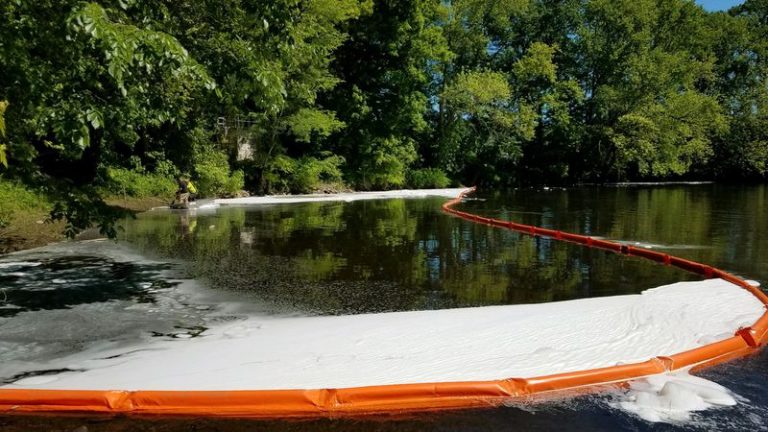Chemical industry lobby opposing strong Connecticut action on PFAS pollution
By Gregory B. Hladky | Hartford Courant | August 11, 2019

Read full article by Gregory B. Hladky (Hartford Courant)
“Growing concern about potentially toxic PFAS pollution in Connecticut has brought demands from environmentalists that a new state task force push for tough controls and restrictions over these controversial ‘forever’ chemicals.
But strong opposition from the chemical industry helped kill a PFAS-control bill in the 2019 General Assembly. Supporters of that failed measure say they expect the American Chemistry Council to work to block any similar legislation in 2020. The council is the primary public relations and lobbying arm of the chemical industry.
‘The chemical industry was really the main one lobbying against it,’ Anne Hulick, head of the Connecticut chapter of Clean Water Action, said of the bill to restrict use of PFAS in firefighting foam and consumer products that died this year.
Hulick said she expects more of the same if the state task force now working on PFAS-related issues recommends strong state action similar to what’s been done in states like New Hampshire, Vermont and Massachusetts…
The industry’s continuing opposition to tough state controls over PFAS comes as no surprise to Connecticut environmentalists. But they believe recent events, including a June 8 spill of tens of thousands of gallons of PFAS firefighting foam into the Farmington River, have brought the PFAS issue to widespread public attention and are likely to provide momentum for state action in 2020.
The June 8 spill occurred as a result of a malfunction at a Bradley Airport hangar operated by Signature Flight. An unknown amount of the potentially toxic chemicals reached the Farmington River in Windsor, which had only recently received a federal designation as a ‘wild and scenic river.’
The massive Bradley Airport spill occurred barely a week after legislators at the Capitol finished work for this year without even taking a vote on PFAS legislation.
The bill that died at the end of the session was a far weaker version of legislation that was originally proposed. The initial legislation called for state action to come up with alternatives to PFAS firefighting foam and consumer packaging and proposed banning those chemicals for those types of products in 2021…
‘The chemical industry pushed back quite a bit,’ said Rep. Jonathan Steinberg, a Westport Democrat who is co-chair of the public health panel, ‘particularly when it came to consumer products’…
‘Any discussion of these substances or their potential health effects in food packaging is irrelevant, inappropriate, and contributing to unnecessary fear about the safety of our food supply,’ said Frank Adamsky, regulatory affairs manager for Daikin America, a major fluorochemical manufacturer and a member of the chemistry council.
Gov. Ned Lamont created the Connecticut task force following the June spill. The task force is working under extreme pressure to come back to Lamont with a series of recommendations for state action on this complex and controversial issue by Oct. 1…
Hulick said her group has asked the state task force to ‘establish health protective drinking water standards,’ to order removal of PFAS chemicals from firefighting foams, set a state timeline for banning PFAS from consumer products and institute more rigorous state testing of water sources for these chemicals.
The American Chemistry Council disagrees with virtually all those goals. In an email response to questions on this issue, council officials said they oppose any outright ban on very effective PFAS firefighting foam. They also insisted the U.S. Food and Drug Administration has already cleared various PFAS chemicals for consumer products.
‘The health experts at FDA have reviewed and determined certain PFAS to be safe for their intended use [in food packaging],’ the council statement said. The industry lobbying group also said it believes ‘state prohibitions on these chemicals are unwarranted’…
In June, the U.S. Food and Drug Administration released the findings of studies that showed PFAS chemicals have been found in some dairy products, animal feed, lettuce and other leafy greens. But the FDA also concluded that the levels of PFAS were not high enough to be health concerns.
The scaled-back PFAS bill eventually died in the 2019 General Assembly when it was sent for consideration to the legislature’s Appropriations Committee because it included a $66,000 spending requirement that wasn’t included in the state’s $21 billion-plus state budget plan…
Hulick and Brown suspect that subtle opposition from the chemical industry had something to do with the bill’s eventual demise in Connecticut. ‘It’s been a very dark, quiet kind of lobbying behind the scenes,’ Brown said of the chemical industry’s efforts on the PFAS legislation…
State officials said Erin DeSantis, the chemistry council’s Northeast regional director, will take part in two task force subcommittees dealing with prevention and human health. DeSantis’s previous experience included working for a New York business group, media relations, and as legislative director for the New York State Assembly.
Jessica Bowman, senior director of global fluoro-chemistry for the chemistry council, will also serve on the pollution prevention subcommittee.”
This content provided by the PFAS Project.
Location:
Topics: